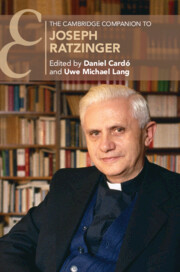66 results
Religion as Liberal Politics
-
- Journal:
- Journal of Law and Religion , First View
- Published online by Cambridge University Press:
- 29 April 2024, pp. 1-22
-
- Article
- Export citation

The Cambridge Companion to Joseph Ratzinger
-
- Published online:
- 25 January 2024
- Print publication:
- 21 December 2023
1 - Essays to Do Good: Puritanism and the Birth of the American Essay
- from Part I - The Emergence of the American Essay (1710–1865)
-
-
- Book:
- The Cambridge History of the American Essay
- Published online:
- 28 March 2024
- Print publication:
- 14 December 2023, pp 15-31
-
- Chapter
- Export citation
5 - The Essay and Transcendentalism
- from Part I - The Emergence of the American Essay (1710–1865)
-
-
- Book:
- The Cambridge History of the American Essay
- Published online:
- 28 March 2024
- Print publication:
- 14 December 2023, pp 81-95
-
- Chapter
- Export citation
12 - Revolution at Geneva: Genevans in Revolution
- from Part II - Western, Central, and Eastern Europe
-
-
- Book:
- The Cambridge History of the Age of Atlantic Revolutions
- Published online:
- 18 October 2023
- Print publication:
- 09 November 2023, pp 329-348
-
- Chapter
- Export citation
7 - ‘Popes and Caesars’
- from Part III - Materiality and Spectacle
-
-
- Book:
- Victorian Engagements with the Bible and Antiquity
- Published online:
- 28 September 2023
- Print publication:
- 12 October 2023, pp 184-208
-
- Chapter
- Export citation
Chapter 4 - “Gathered again from the ash”
- from Part II - The Politics of Memory and Affect
-
-
- Book:
- Memory and Affect in Shakespeare's England
- Published online:
- 07 June 2023
- Print publication:
- 27 July 2023, pp 89-105
-
- Chapter
- Export citation
Religious Dynamics and Conflicts in Contemporary Ethiopia: Expansion, Protection, and Reclaiming Space
-
- Journal:
- African Studies Review / Volume 66 / Issue 3 / September 2023
- Published online by Cambridge University Press:
- 11 April 2023, pp. 721-744
-
- Article
-
- You have access
- Open access
- HTML
- Export citation
9 - Preachers, Puritans and the Religion of Lawyers
-
- Book:
- The Inns of Court under Elizabeth I and the Early Stuarts
- Published online:
- 15 January 2023
- Print publication:
- 05 January 2023, pp 235-271
-
- Chapter
- Export citation
1 - Introduction: Life, Work and Historical Context
-
-
- Book:
- The Cambridge Companion to Pufendorf
- Published online:
- 25 November 2022
- Print publication:
- 17 November 2022, pp 1-32
-
- Chapter
- Export citation
Beyond the Underdog Mentality: Philo-Semitism amongst Protestant Rescuers in Wartime Ukraine
-
- Journal:
- Harvard Theological Review / Volume 115 / Issue 4 / October 2022
- Published online by Cambridge University Press:
- 09 November 2022, pp. 538-565
- Print publication:
- October 2022
-
- Article
-
- You have access
- Open access
- HTML
- Export citation
15 - Protestantism and Human Dignity in South Korea
-
-
- Book:
- Human Dignity in Asia
- Published online:
- 26 July 2022
- Print publication:
- 15 September 2022, pp 356-378
-
- Chapter
- Export citation
A New Jerusalem: Flavius Josephus in Early America
-
- Journal:
- Church History / Volume 91 / Issue 3 / September 2022
- Published online by Cambridge University Press:
- 16 December 2022, pp. 555-574
- Print publication:
- September 2022
-
- Article
- Export citation
3 - Long-Run Factors
-
-
- Book:
- Why Democracies Develop and Decline
- Published online:
- 28 June 2022
- Print publication:
- 23 June 2022, pp 55-79
-
- Chapter
- Export citation
Conclusion
-
- Book:
- Reformation in the Low Countries, 1500-1620
- Published online:
- 02 June 2022
- Print publication:
- 09 June 2022, pp 182-196
-
- Chapter
- Export citation
Law at the Backbone: The Christian Legal Ecumenism of Norman Doe
-
- Journal:
- Ecclesiastical Law Journal / Volume 24 / Issue 2 / May 2022
- Published online by Cambridge University Press:
- 29 April 2022, pp. 192-208
- Print publication:
- May 2022
-
- Article
-
- You have access
- Open access
- HTML
- Export citation
Chapter 38 - Faith, Spirituality, and the Church
- from Part V - British Sociocultural, Religious, and Political Life
-
-
- Book:
- Benjamin Britten in Context
- Published online:
- 31 March 2022
- Print publication:
- 21 April 2022, pp 334-342
-
- Chapter
- Export citation
II.3 - Theological Method and the Foundations of Protestant Faith
- from Part II - Pierre Bayle and the Emancipation of Religion from Philosophy
-
- Book:
- The Kingdom of Darkness
- Published online:
- 23 March 2022
- Print publication:
- 31 March 2022, pp 375-422
-
- Chapter
- Export citation
Four Axes of Mission: Conversion and the Purposes of Mission in Protestant History
-
- Journal:
- Transactions of the Royal Historical Society / Volume 32 / December 2022
- Published online by Cambridge University Press:
- 22 March 2022, pp. 113-133
- Print publication:
- December 2022
-
- Article
- Export citation
Chapter 3 - Christianity
- from Part I - Historical Developments
-
-
- Book:
- The Cambridge Companion to British Romanticism and Religion
- Published online:
- 01 October 2021
- Print publication:
- 21 October 2021, pp 31-49
-
- Chapter
- Export citation



